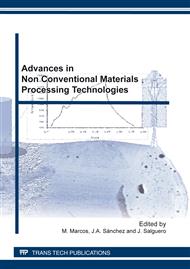p.85
p.91
p.97
p.103
p.109
p.115
p.121
p.127
p.133
Parameter Study on Laser Surface Finishing with 2D Scan Head
Abstract:
In recent years laser polishing is becoming an alternative for automated surface finishing of dies and molds. This process involves melting and subsequent solidification of the material. Depending on the initial topography, the energy density necessary to reduce surface asperities can cause excessive heat damage, and thus, limit the applicability of the process. The work presented here focuses on the use of a high quality laser beam, with a spot diameter below 50 microns driven by a 2D scanner for processing of materials typically used in dies and mold manufacturing. So, the highly focused beam ensures minimal thermal damage, and the scan head allows high productivity rates. A new processing strategy based on two stages surface processing was developed to process topographies with strong directionality.
Info:
Periodical:
Pages:
109-114
Citation:
Online since:
February 2012
Authors:
Price:
Сopyright:
© 2012 Trans Tech Publications Ltd. All Rights Reserved
Share:
Citation:


